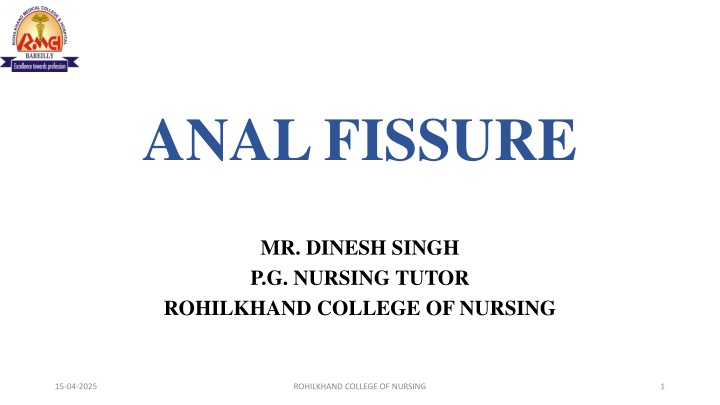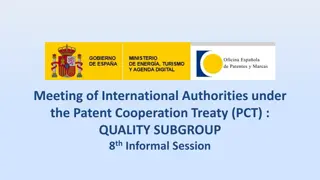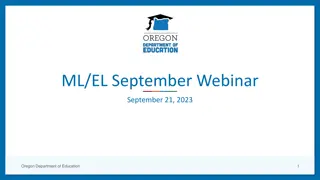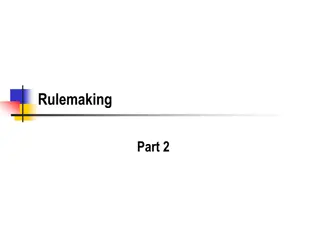
Anal Fissures: Causes, Symptoms, and Management
Learn about anal fissures, a common condition characterized by a tear in the anus lining. Discover the causes, symptoms, diagnostic evaluation, and management strategies for anal fissures. Explore how to prevent this painful condition effectively.
Download Presentation

Please find below an Image/Link to download the presentation.
The content on the website is provided AS IS for your information and personal use only. It may not be sold, licensed, or shared on other websites without obtaining consent from the author. If you encounter any issues during the download, it is possible that the publisher has removed the file from their server.
You are allowed to download the files provided on this website for personal or commercial use, subject to the condition that they are used lawfully. All files are the property of their respective owners.
The content on the website is provided AS IS for your information and personal use only. It may not be sold, licensed, or shared on other websites without obtaining consent from the author.
E N D
Presentation Transcript
ANAL FISSURE MR. DINESH SINGH P.G. NURSING TUTOR ROHILKHAND COLLEGE OF NURSING 15-04-2025 ROHILKHAND COLLEGE OF NURSING 1
OBJECTIVES Introduction of the Anal fissure. Define the Anal fissure. Explain the causes of Anal fissure. State the clinical manifestations of Anal fissure. Elaborate the diagnostic evaluation of Anal fissure. Discuss the management of Anal fissure. Describe the prevention of Anal fissure. 15-04-2025 ROHILKHAND COLLEGE OF NURSING 2
INTRODUCTION An anal fissure is a small tear in the thin, moist tissue that lines the anus. The anus is the muscular opening at the end of the digestive tract where stool exits the body. Common causes of an anal fissure include constipation and straining or passing hard or large stools during a bowel movement. 15-04-2025 ROHILKHAND COLLEGE OF NURSING 3
DEFINITION Anal fissure is linear laceration of anal epithelium associated with constipation. 15-04-2025 ROHILKHAND COLLEGE OF NURSING 4
ETIOLOGY Common causes of anal fissures include: Passing large or hard stools. Constipation during bowel movements. Long-lasting diarrhea. Childbirth. 15-04-2025 ROHILKHAND COLLEGE OF NURSING 5
Cont Less common causes of anal fissures include: Crohn's disease or another inflammatory bowel disease. Anal cancer. HIV. Tuberculosis. Syphilis. 15-04-2025 ROHILKHAND COLLEGE OF NURSING 6
PATHOPHYSIOLOGY Constipation Hard faces Tear in anal canal mucosa (fissure) Severe anal pain Spasm of the internal sphincter Impairment of intersphincteric blood circulation Impaired healing Chronic anal Fissure 15-04-2025 ROHILKHAND COLLEGE OF NURSING 7
CLINICAL MANIFESTATION Pain during bowel movements. Pain after bowel movements that can last up to several hours. Bright red blood on the stool or toilet paper after a bowel movement. A visible crack in the skin around the anus. A small lump or skin tag on the skin near the anal fissure. 15-04-2025 ROHILKHAND COLLEGE OF NURSING 8
DIAGNOSTIC EVALUATION Anoscopy. An anoscope is a tubular device inserted into the anus to help your provider see the rectum and anus. Flexible sigmoidoscopy. health care provider inserts a thin, flexible tube with a tiny video into the bottom portion of the colon. This test may be done if patient younger than 45 and have no risk factors for intestinal diseases or colon cancer. Colonoscopy. This test involves inserting a flexible tube into your rectum to inspect the entire colon. Colonoscopy may be done. 15-04-2025 ROHILKHAND COLLEGE OF NURSING 9
MANAGEMENT Externally applied nitroglycerin: This can help increase blood flow to the fissure and promote healing. It also can help relax the anal sphincter. Topical anesthetic creams such as lidocaine (Xylocaine) may help relieve pain OnabotulinumtoxinA (Botox) injection, to paralyze the anal sphincter muscle and relax spasms. Antibiotics Stool softeners or laxatives, e.g., bisacodyl 15-04-2025 ROHILKHAND COLLEGE OF NURSING 10
SURGICAL MANAGEMENT Sphincterotomy: Doctors usually perform a procedure called lateral internal sphincterotomy (LIS). LIS involves cutting a small portion of the anal sphincter muscle. This technique may help promote healing and reduce spasm and pain. 15-04-2025 ROHILKHAND COLLEGE OF NURSING 11
SUMMARY 15-04-2025 ROHILKHAND COLLEGE OF NURSING 12
REFERENCES 15-04-2025 ROHILKHAND COLLEGE OF NURSING 13
15-04-2025 ROHILKHAND COLLEGE OF NURSING 14







